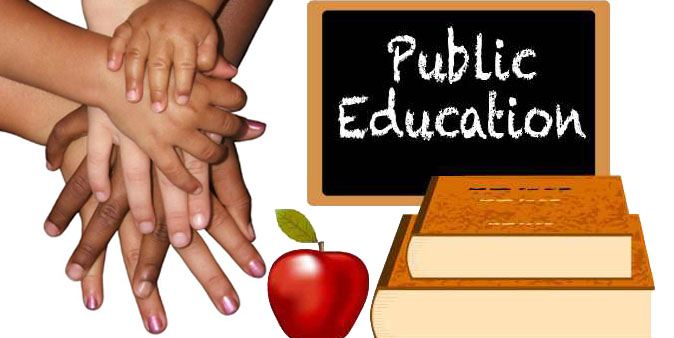- Mandated for the children of the general public by the government, whether national, regional, or local, provided by an institution of civil government, and paid for, in whole or in part, by taxes.
- Applied to basic education, K -12 education or primary and secondary education: it is rarely, if ever, applied to post-secondary education, advanced education, or universities, colleges, or technical schools.
- A civil institution; that is, the main decisions about access, curriculum, and allocation of resources are made by a civil authority (government) or by the employees of a civil authority.
- Comprehensive, both in its treatment of students and that enfranchisement for the government of public education is as broad as for government generally.
- Often structured and operated to be a deliberate model of the civil community in which it functions.
- This can be offered by a national or regional government (province, state, territory, etc.), or it may be provided by a local (non-state) government.
- Rarely referred to as “state education” if public education is provided by local government.
- Usually provided to groups of students (classrooms; the “one to many” model of delivery), with a number of groups of students clustered in a school. However, the term “public education” is not synonymous with “public schooling”. Public education can be provided in-home, employing visiting teachers, supervising teachers, and/or distance learning. It can also be provided in non-school, non-home settings, such as shopping mall space.
- Not synonymous with the term “publicly funded education“. Government may make a public policy decision that it wants to have some financial resources distributed in support of, and it may want to have some control over, the provision of education which is not public education. Grants-in-aid of private schools, and voucher systems all provide examples of publicly funded education which is not public education. Conversely, a public school (including ones run by school districts) may rely heavily on non-public funding (such as high fees or private donations) but still be considered public by virtue of public ownership and control.
Public education often includes the following:
- Mandatory student attendance (until a certain age or standard is achieved);
- Certification of teachers and curricula, either by the government or by a teachers’ organization;
- Testing and standards given by government.
Funding
A number of issues swirl around the problems of public education but these concerns dominate conversations regarding school finance:
- Private and public good of education
Adam Smith in The Wealth of Nations discusses, at length, the importance of an educated populace. Studies show comparisons of the cost of one year of school to the cost of one year of prison demonstrating that prison is far more costly. Though the links between education and prisons are debatable, evidence suggests a strong correlation between lack of education and likelihood of committing a crime and being incarcerated. States with low-dropout rates have a lower rate of incarceration.
The public good comes into question as well when considering how school districts set their boundaries, granting and limiting access to students based on their physical and financial positions in the community. Arguments over the borders of school districts frequently involve issues of race and class.
- Autonomy
Responding to criticisms of failures of management because of highly centralized structures, site-based management has come to the fore as a way to improve academic performance with localized solutions.
- Concept of fiscal federalism
Funding is multi-layered. While it is generally the local tax base which is accountable for supporting the schools, a certain amount of funding is also passed on from the state and federal levels. Recently, as the federal government decreases support for education the schools are forced into painful fiscal adjustments as promised moneys never arrive.
The funding of programs for students with special mental or physical needs and the extent of access, inclusion, and opportunity provided to such students.
